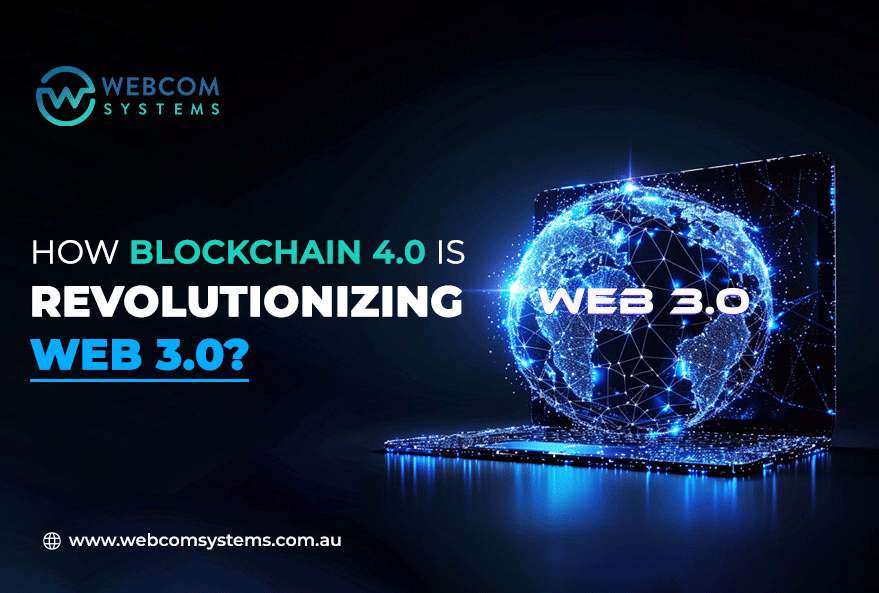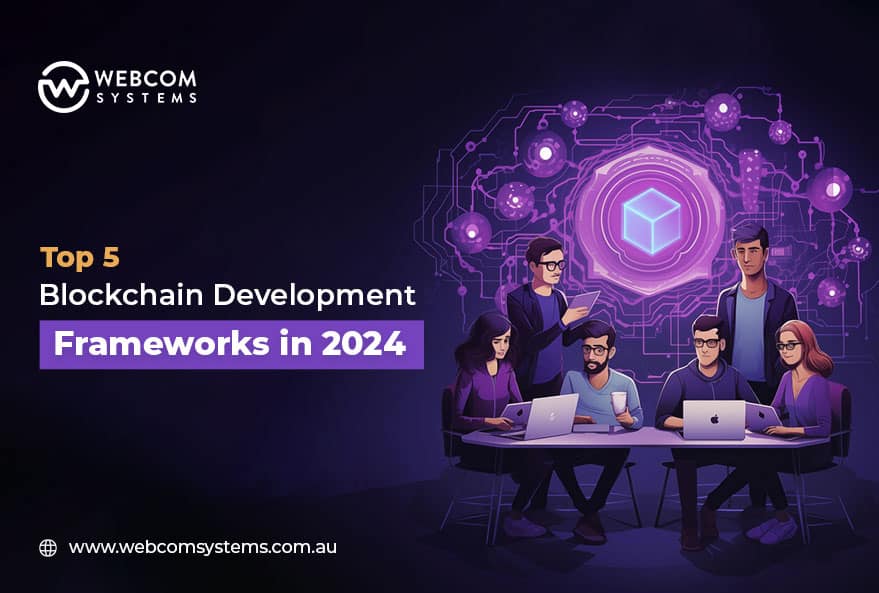How Blockchain 4.0 is Revolutionizing Web 3.0?
Category : Blockchain, WEB 3.0 / by Andrew
The internet has undergone various changes since its birth. From Web 3.0 to Blockchain 4.0, the web has introduced new features from its predecessors. Blockchains have undergone various versions, from version 1.0 to version 4.0. By the end of 2026, it is estimated that the blockchain market will be worth 68 billion dollars. Blockchain 4.0 and Web 3.0 are crucial in shaping the future of technology.
This article discusses the integration of Blockchain 4.0 and Web 3.0 and the benefits, challenges, and opportunities of the transformation.
What is blockchain 4.0?
Blockchain 4.0 is the new version of blockchain, focusing on innovation and user experience. It also introduces new features that set them apart from previous versions. Unlike the previous versions, Blockchain 4.0 emphasizes speed, scalability, and security while serving a wider user base. It has also addressed the scalability issues that hindered the previous versions. Blockchain 4.0 aims to provide a strong and adaptable environment for dApp development.
Blockchain 4.0 has the power to revolutionize Web 3.0 by offering a more secure, efficient, and user-centric blockchain ecosystem. You can now exchange assets and data across multiple platforms by using Blockchain 4.0.
The third generation of blockchain is mainly focused on fixing the issues of the second generation. The fourth generation of blockchain will act as a new generation of technology by creating and running improved versions of decentralized applications. Blockchain can be distinguished from its previous version by the following features:.
- Scalability: Blockchain 4.0 implements new techniques such as sharding, state channels, or layer two solutions for overcoming scalability issues.
- Interoperability: Blockchain 4.0 can also be used to exchange assets safely across multiple platforms as it provides interoperability between different blockchain networks and protocols.
- Security and Privacy: Blockchain 4.0 uses strong security measures and enhanced privacy features to protect user data. These measures include advanced cryptographic techniques, zero-knowledge proofs, and privacy-preserving protocols that enable transparency.
What is Web 3.0?
Web 3.0 employs a range of technologies, such as IoT, blockchain, and artificial intelligence. Web 3.0 is also known as the semantic web. The users of Web 3.0 have greater power, making the web a more user-centric platform.
Web 3.0 has opened up new ways of socializing. However, many customers have stored their data on centralized systems, exposing them to cyber threats. The global financial crisis has exposed these cracks by showcasing the importance of a decentralized system. Web 3.0 is designed to have decentralization at its core. Therefore, blockchain plays an important role in its development.
The Intersection of Blockchain 4.0 and Web 3.0
Web 3.0 aims to create an autonomous, open, and intelligent internet with the use of blockchain 4.0. There are already third-generation blockchains that support Web 3.0. With the rise of blockchain 4.0, we can expect to see more web 3.0-focused chains that make use of interoperability, automation through smart contracts, seamless integration, and censorship-resistant storage of P2P data files.
The integration of Blockchain 4.0 with Web 3.0 provides users greater control over their data and enables them to decide who can access their information. Blockchain 4.0 is also used for creating engaging metaverse experiences that provide greater control for users over their digital assets.
The integrated versions of Blockchain 4.0 and Web 3.0 can be seen in sectors like supply chain management, healthcare, and finance. With the use of smart contracts and censorship-resistant storage, blockchain can be used to enhance various sectors. Blockchain 4.0 technologies like smart contracts and decentralized applications (DApps) are driving the development of Web 3.0. Smart contracts are self-executing contracts that enable automation. DApps utilize this technology for various purposes, such as decentralized finance (DeFi), supply chain management, and identity verification.
The Applications of Blockchain 4.0 in Web 3.0
Blockchain 4.0 and Web 3.0 represent significant advancements in technology, each offering unique benefits for businesses. When combined, they create a powerful ecosystem that can revolutionize various industries. Here are some of the benefits of using Blockchain 4.0 in Web 3.0 for businesses:
- Enhanced Security: Blockchain 4.0 utilizes advanced cryptographic techniques to ensure the integrity and security of data. In Web 3.0, this translates to enhanced security for business transactions, sensitive information, and digital assets. The decentralized nature of blockchain reduces the risk of single points of failure and unauthorized access, making it more difficult for hackers to compromise data.
Transparent and Trustworthy Transactions: Blockchain technology enables transparent and immutable transaction records, providing businesses and their customers with a high level of trust. In Web 3.0, smart contracts built on blockchain 4.0 platforms automate and enforce agreements, ensuring that transactions are executed exactly as intended without the need for intermediaries. This transparency fosters trust among parties involved in business transactions. - Improved Efficiency and Cost Savings: By eliminating intermediaries and automating processes through smart contracts, businesses can streamline operations, reduce administrative overhead, and minimize the risk of errors or fraud. Blockchain 4.0 in Web 3.0 enables faster settlement times, lower transaction fees, and improved overall efficiency, leading to significant cost savings for businesses.
- Global Accessibility and Interoperability: Web 3.0, powered by blockchain 4.0 technologies, facilitates global connectivity and interoperability. Businesses can seamlessly transact with partners, suppliers, and customers across geographical boundaries without the need for traditional financial intermediaries or complex cross-border payment systems. This opens up new markets and opportunities for growth.
- Data Privacy and Ownership: In Web 3.0, individuals have greater control over their data, thanks to decentralized identity and authentication systems built on blockchain 4.0 platforms. Businesses can leverage these technologies to enhance data privacy, comply with regulations such as GDPR, and empower users to retain ownership of their personal information. This fosters trust and loyalty among customers.
- Innovative Business Models: Blockchain 4.0 in Web 3.0 enables the creation of new, innovative business models that were previously not feasible. From decentralized finance (DeFi) to tokenization of assets, businesses can explore novel ways to raise capital, incentivize user participation, and monetize digital assets. Smart contracts enable programmable money, enabling businesses to automate revenue-sharing, royalties, and other financial arrangements.
Challenges
While Blockchain 4.0 in Web 3.0 presents significant benefits for businesses, it also comes with several challenges that need to be addressed:
- Scalability: Blockchain scalability is one of the most serious issues that needs to be addressed. When the network processes a larger number of transactions, the scalability problem becomes more evident, as it leads to congestion and slower transaction times. Solutions such as sharding, layer 2 protocols, and better consensus algorithms are being built, but there is still a lot of progress needed before they can be widely adopted and implemented.
- Interoperability: The inability of different blockchain networks to communicate smoothly with traditional systems is still a matter of concern. Businesses may be required to interconnect with many blockchain platforms and traditional databases so that it will be impossible to run their apps smoothly without having interoperation to make sure their data exchange and transaction processing run smoothly. While interoperability standards and protocols have been in development and followed the appropriate process of being trialed, this process is still evolving, and integration of the system remains complex and time-consuming.
- Regulatory Uncertainty: The crypto market is prone to price fluctuations owing to factors such as exchange rates, investor sentiments, and economic conditions. The regulatory environment across different jurisdictions is constantly changing and varies substantially. Organizations confront the challenges of compliance due to regulatory requirements, inhibiting business expansion and adoption of new technology. Developing blockchain initiatives entails the challenges caused by uncertain tax legislation, securities regulations, and data privacy laws.
- Security Concerns: Blockchain technology is identified for the additional advantage of having characteristics such as immutability and providing cryptographic protection features; however, that does not guarantee that blockchain technology is vulnerability-free. Smart contract bugs, 51% attacks, and exploits on blockchain protocols can be dangerous as they lead to monetary losses and a bad reputation for the business. Strong security measures, audits from time to time, and ongoing monitoring should be implemented to tackle the risks of data incidents among frontrunners.
- User Experience: The customers’ feelings about using blockchain applications and platforms of a decentralized nature are often less appealing in comparison with the common industry standards. Problems like dealing with complicated wallet management, transaction fees, and unknown user interfaces may slow down users from adopting blockchain-based solutions. Increasing customer experience via user-friendly interfaces, simplified setup, implementation, and edification is core to the success of offering mainstream consumers the chance to participate in crypto.
Opportunities
Here are some opportunities presented by the combination of Blockchain 4.0 and Web 3.0 for businesses:
- New Revenue Streams: Blockchain 4.0 in Web 3.0 gives businesses opportunities to try out asset tokenization, decentralized finance (DeFi), and NFT to get additional income. Through the integration of blockchain, business organizations can make use of digital asset establishment and monetization, tokenize securities, facilitate peer-to-peer lending and trading, and generate new findings.
- Enhanced Customer Engagement: Web 3.0 applications could be made better by using Blockchains to make customers feel attracted by using token rewards, decentralized authority, and customized experiences.
- Supply Chain Optimization: Blockchain technology includes the elective factors such as transparent, traceability, and immutability of data in the supply chain management optimization . Businesses can utilize blockchain 4.0 solutions to track product provenance, authenticate goods, and simplify supply chain processes; it results in accelerated efficiency, cost reduction, and high engagement of the stakeholders through the trust enhancement.
- Decentralized Identity and Authentication: Web 3.0 has brought elements of decentralized identity that are based on blockchain technology which allows businesses to improve security and privacy while, at the same time, users can enjoy a user authentication process that is seamless. Organizations can help to decrease the possibility of identity theft, and simplify the login process by implementing the decentralized identity systems. Further, it can be used to come into line with the data regulations.
- Global Market Expansion: Blockchain-powered applications in Web 3.0 support global connectivity and make it easier for businesses to target new markets and customers because there are no payment processors or overseas payment systems required. Smart contracts and decentralized marketplaces grant businesses the ability to operate directly with customers globally so that new markets as well as niche segments can be reached.
Bottomline
Blockchain is advancing to its fourth generation at a really fast pace. It is designed to address the limitations of its previous versions, making it the ultimate blockchain technology to apply for Web 3.0 applications development . We can expect to see more exciting innovations through the integration of Blockchain 4.0 with Web 3.0 in the upcoming years.
At Webcom Systems, we cater to your end-to-end blockchain development needs. Our developers are well trained with all types of Blockchains, including 2nd and 3rd generation chains; private, public, and hybrid chains. We assist you in conducting projects in the Metaverse and Web 3.0 by using the latest technology. We offer all-inclusive development services for smart contracts, wallets, dApps, Defi platforms, NFTs, NFT marketplaces, and anything else blockchain-related.




